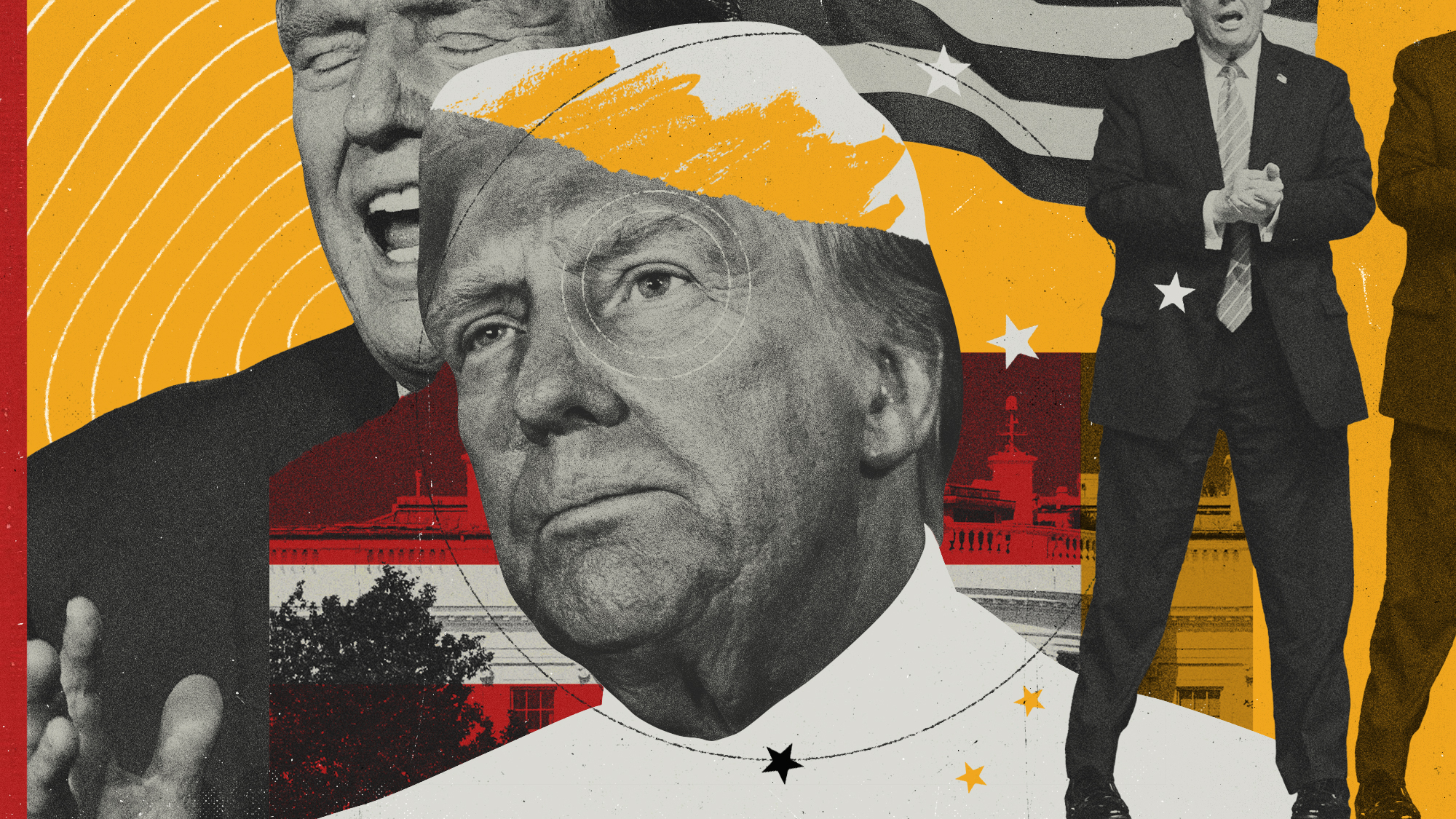The Tea Party's big idea to shrink government is a vacuous nothingburger
Meet the Penny Plan


Insurgent political movements are usually built around a big idea, like abolition or workers' rights. The Tea Party certainly has a big idea: Shrink the government.
Wanting to shrink the government is a perfectly reasonable impulse given the state of Washington's finances. The federal debt has more than doubled as a share of GDP since 2007, and future spending projects are off the charts. The latest academic evidence suggests an increase in government size is associated with slower annual GDP growth.
It's easy to see why this shrink-the-government idea is powerful, and how it fueled the Tea Party's rapid ascent into a rocket-powered force on the right.
The Week
Escape your echo chamber. Get the facts behind the news, plus analysis from multiple perspectives.

Sign up for The Week's Free Newsletters
From our morning news briefing to a weekly Good News Newsletter, get the best of The Week delivered directly to your inbox.
From our morning news briefing to a weekly Good News Newsletter, get the best of The Week delivered directly to your inbox.
However, a big idea alone is not sufficiently enough, in and of itself, to guarantee success. And therein lies the Tea Party's big problem.
The Tea Party's blueprint for turning their raison d'être into reality is flawed. Called the "Penny Plan," it's a favorite of the Tea Party Patriots, media supporters such as Sean Hannity of Fox News, and fellow travelers in Congress, including possible 2016 presidential candidate Rand Paul and — perhaps most importantly — Mike Enzi, the new Republican chairman of the Senate Budget Committee.
First devised by Georgia businessman Bruce Cook, the Penny Plan would cut government spending by 1 percent a year until the federal budget is balanced. After that, federal spending would be capped at 18 percent of GDP, to match the long-term revenue trend. Here's how Enzi touts the plan on his website:
Though only a 1 percent cut, the savings add up quickly to balance the budget. And if it's done right, where we're eliminating duplication and sensibly prioritizing, discomfort will be manageable. … Living with 1 percent less is a small price to pay in order to help bring this country back from the brink of catastrophic fiscal failure. [Enzi]
It sounds so simple! Well, it really isn't.
A free daily email with the biggest news stories of the day – and the best features from TheWeek.com
For starters, the "penny" part of the plan is a gimmick, more about marketing than math. The Enzi version would cut 1 percent a year from total government spending, other than debt interest payments, for three years. Maybe that doesn't sound like much. But once you factor in inflation, that works out to a 10 percent cut in real terms after three years.
Now maybe that still doesn't sound like much. But getting such a reduction is tough enough that there are no details in the Penny Plan about what exactly would be cut. To balance the budget in 2018, according to CBO, it would require $540 billion in reduced spending. It can't all come from reducing non-defense discretionary spending such as foreign aid or scientific research. That part of the budget, just 17 percent, or around $600 billion, is already at its lowest levels since the 1960s as a share of GDP.
That leads to a bigger problem with the Penny Plan: Is it realistic to cap long-term government spending at 18 percent of GDP — well less than the post-WWII average of 21 percent — when an aging population means increased spending on entitlements such as Medicare and Social Security? Remember, most of the spending increase from health-related entitlements and Social Security — 75 percent over the next quarter century — comes from simple demographics, more people getting benefits over a longer period of time. That works out to about 3 percentage points of GDP in additional spending baked into the budgetary cake. Overall, CBO projects total spending at 26 percent of GDP by 2039.
Just keeping long-term spending at its historic average will be a huge challenge, much less sharply reducing it. If you also want to spend a bit more on important public investments such as infrastructure and basic research while keeping military spending constant — well, good luck. Even the GOP Senate's new balanced budget amendment — which doesn't calculate debt interest payments as spending — would have a tough time hitting its 18 percent target.
That the Penny Plan offers zero specifics on how to make the numbers work undercuts its seriousness. It would obviously require sweeping entitlement reform — and more. But Enzi, for one, argues that "we should focus on identifying and eliminating all of the wasteful spending that occurs in Washington before we look to other important programs and services." That's an evasion, though hardly a surprising one from a party that depends on older voters.
In fact, some on the right are trying to fudge that political reality by distinguishing between "earned" entitlements — Social Security and Medicare — that go to GOP-leaning voters and "unearned" entitlements — such as Medicaid and ObamaCare subsidies — that go to Democratic-leaning voters.
So yes, the Tea Party has a big idea. But it has no idea how to make it happen.
James Pethokoukis is the DeWitt Wallace Fellow at the American Enterprise Institute where he runs the AEIdeas blog. He has also written for The New York Times, National Review, Commentary, The Weekly Standard, and other places.
-
 Bluetoothing: the phenomenon driving HIV spike in Fiji
Bluetoothing: the phenomenon driving HIV spike in FijiUnder the Radar ‘Blood-swapping’ between drug users fuelling growing health crisis on Pacific island
-
 Marisa Silver’s 6 favorite books that capture a lifetime
Marisa Silver’s 6 favorite books that capture a lifetimeFeature The author recommends works by John Williams, Ian McEwan, and more
-
 Book reviews: ‘We the People: A History of the U.S. Constitution’ and ‘Will There Ever Be Another You’
Book reviews: ‘We the People: A History of the U.S. Constitution’ and ‘Will There Ever Be Another You’Feature The many attempts to amend the U.S. Constitution and Patricia Lockwood’s struggle with long Covid
-
 Ghislaine Maxwell: angling for a Trump pardon
Ghislaine Maxwell: angling for a Trump pardonTalking Point Convicted sex trafficker's testimony could shed new light on president's links to Jeffrey Epstein
-
 The last words and final moments of 40 presidents
The last words and final moments of 40 presidentsThe Explainer Some are eloquent quotes worthy of the holders of the highest office in the nation, and others... aren't
-
 The JFK files: the truth at last?
The JFK files: the truth at last?In The Spotlight More than 64,000 previously classified documents relating the 1963 assassination of John F. Kennedy have been released by the Trump administration
-
 'Seriously, not literally': how should the world take Donald Trump?
'Seriously, not literally': how should the world take Donald Trump?Today's big question White House rhetoric and reality look likely to become increasingly blurred
-
 Will Trump's 'madman' strategy pay off?
Will Trump's 'madman' strategy pay off?Today's Big Question Incoming US president likes to seem unpredictable but, this time round, world leaders could be wise to his playbook
-
 Democrats vs. Republicans: which party are the billionaires backing?
Democrats vs. Republicans: which party are the billionaires backing?The Explainer Younger tech titans join 'boys' club throwing money and support' behind President Trump, while older plutocrats quietly rebuke new administration
-
 US election: where things stand with one week to go
US election: where things stand with one week to goThe Explainer Harris' lead in the polls has been narrowing in Trump's favour, but her campaign remains 'cautiously optimistic'
-
 Is Trump okay?
Is Trump okay?Today's Big Question Former president's mental fitness and alleged cognitive decline firmly back in the spotlight after 'bizarre' town hall event
